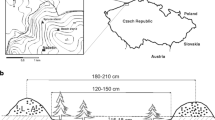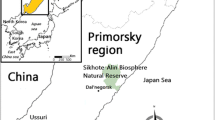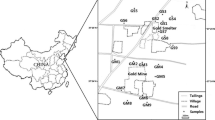Abstract
Purpose
This paper focuses on determining the geochemical fractionation pattern of trace elements (As, Cd, Cu, Pb, Tl, and Zn) naturally occurring at elevated levels in chestnut grove soils of SW Spain. The goal was to explore how environmental changes triggered by land use and management decisions might affect the resilience and adaptive capacity of soil to retain geogenic trace elements.
Materials and methods
Two plausible scenarios were considered: conversion of forestland to cropland (scenario I) and mining area (scenario II). The potential for trace element removal under the assumed scenarios was assessed by chemical extraction procedures designed to simulate the combined effects of experimentally induced pH and redox changes. Trace elements were partitioned into residual and labile fractions using a five-step sequential extraction scheme optimized for soils enriched in well-crystallized Fe oxides, and their concentrations in the soil extract solutions were measured by inductively coupled plasma mass spectrometry.
Results and discussion
Most metals are tightly bonded to residual and reducible phases, indicating that silicate minerals and Fe oxy-hydroxides, respectively, played a remarkable role in the metal geo-accumulation. Limited mobilization and dispersion of exchangeable and acid-soluble contaminants would be expected to occur through releases or accidental spills from hazardous wastes. An increase in the oxidation state of the soil environment would affect the stability of the organic matter involving the release of the associated trace elements, particularly Cu. Upon reducing conditions induced by land-degradation processes, reductive dissolution of Fe oxy-hydroxides could release large proportions (45–60%) of adsorbed and occluded potentially harmful elements, notably As, Pb, and Cd.
Conclusions
The increasing abandonment of the chestnut groves constitutes a driving force for environmental changes that might affect the geochemical status of the trace elements stored in the soil. Soil could shift from a sink to a source of harmful contaminants over time. This fact should be considered by local stakeholders engaged in planning and decision-making on future land uses.






Similar content being viewed by others
References
AEMET-IM (2011) Iberian Climate Atlas. Air Temperature and Precipitation (1971-2000). Agencia Estatal de Meteorología - Instituto de Meteorologia www.aemet.es/documentos/es/conocermas/publicaciones/Atlas-climatologico/Atlas.pdf. Accessed 22 May 2019
Bain DC (2007) Soil clay minerals and their relevance to environmental change. Macla 7:57–59
Bain DC, Griffen DT (2002) Possible effects of land use on the clay mineralogy of a brown forest soil. Clay Miner 37:663–670
Bourg ACM (1995) Speciation of heavy metals in soils and groundwater and implications for their natural and provoked mobility. In: Salomons W, Förster U, Mader P (eds) Heavy Metals Problems and Solutions. Springer, Berlin, pp 19–31
Brinkman R (1997) Land quality indicators: aspects of land use, land, soil and plant nutrients. In: Land Quality Indicators and Their Use in Sustainable Agriculture and Rural Development. FAO Land Water Bull 5:95–103
Candeias C, Ferreira da Silva E, Salgueiro AR, Pereira HG, Reis AP, Patinha C, Matos JX, Avila PH (2011) Assessment of soil contamination by potentially toxic elements in the Aljustrel mining area in order to implement soil reclamation strategies. Land Degrad Dev 22:565–585
Degryse F, Smolders E, Parker DR (2009) Partitioning of metals (Cd, Co, Cu, Ni, Pb, Zn) in soils: concepts, methodologies, prediction and applications – a review. Eur J Soil Sci 60:590–612
Fernández-Caliani JC, Barba-Brioso C, González I, Galán E (2009) Heavy metal pollution in soils around the abandoned mine sites of the Iberian Pyrite Belt (Southwest Spain). Water Air Soil Pollut 200:211–226
Fernández-Caliani JC, Giráldez I, Rivera MB, Barba-Brioso C (2011) Geochemical partitioning and mineral speciation of Zn in naturally metal-enriched soils of SW Spain. Goldschmidt Conference Abstracts, Mineral Mag 75:840–840
Fernández-Caliani JC, Timón V, Rivera MB, Giráldez I, Pérez-López R (2013) Experimental and theoretical evidence of zinc structurally bound in vermiculite from naturally metal-enriched soils. Clay Miner 48:529–541
Fernández-Caliani JC, Giráldez I, Rivera MB (2019) Source and geochemical partitioning of silver in a naturally-enriched soil. Appl Geochem 103:85–96
Galán E, Gómez-Ariza JL, González I, Fernández-Caliani JC, Morales E, Giráldez I (2003). Heavy metal partitioning in river sediments severely polluted by acid mine drainage in the Iberian Pyrite Belt. Applied Geochemistry, 18:409–421
Galán E, Fernández-Caliani JC, González I, Aparicio P, Romero A (2008) Influence of geological setting on geochemical baselines of trace elements in soils. Application to soils of South-West Spain. J Geochem Expl 98:89–106
Jacobson AR, McBride MB, Baveye P, Steenhuis TS (2005) Environmental factors determining the trace-level sorption of silver and thallium to soils. Sci Total Environ 345:191–205
Kabata-Pendias A (1993) Behavioural properties of trace metals in soils. Appl Geochem 8(Suppl 2):3–9
Liu Y, Xiao T, Baveye PC, Zhu J, Ning Z, Li H (2015) Potential health risk in areas with high naturally-occurring cadmium background in southwestern China. Ecotoxicol Environ Saf 112:122–131
López M, González I, Romero A (2008) Trace elements contamination of agricultural soils affected by sulphide exploitation (Iberian Pyrite Belt, SW Spain). Environ Geol 54:805–818
Pueyo M, Sastre J, Hernández E, Vidal M, López-Sánchez JF, Rauret G (2003) Prediction of trace element mobility in contaminated soils by sequential extraction. J Environ Qual 32:2054–2066. https://doi.org/10.2134/jeq2003.2054
Rauret G, López-Sánchez JF, Sahuquillo A, Rubio R, Davidson C, Ure A, Quevauviller P (1999) Improvement of the BCR three step sequential extraction procedure prior to the certification of new sediment and soil reference materials. J Environ Monit 1:57–61
Rivera MB (2017) Enriquecimiento supergénico, fraccionamiento geoquímico y destino ambiental de elementos traza potencialmente tóxicos en suelos del Parque Natural Sierra de Aracena y Picos de Aroche (Huelva). PhD Thesis, Univ Huelva, Spain
Rivera MB, Fernández-Caliani JC, Giráldez MI (2015) Geoavailability of lithogenic trace elements of environmental concern and supergene enrichment in soils of the Sierra de Aracena Natural Park (SW Spain). Geoderma 259-260:164–173
Rivera MB, Giráldez MI, Fernández-Caliani JC (2016) Assessing the environmental availability of heavy metals in geogenically contaminated soils of the Sierra de Aracena Natural Park (SW Spain). Is there a health risk? Sci Total Environ 560-561:254–265
Smith KS (2007) Strategies to predict metal mobility in surficial mining environments. Rev Eng Geol 17:25–45
Smith P, House JI, Bustamante M et al (2016) Global change pressures on soils from land use and management. Glob Chang Biol 22:1008–1028
Stigliani WM (1988) Changes in valued “capacities” of soils and sediments as indicators of nonlinear and time-delayed environmental effects. Environ Monit Assess 10:245–307
Stigliani WM, Doelman P, Salomons W, Schulin R, Smidt GRB, Van der Zee SEATM (1991) Chemical Time Bombs: predicting the unpredictable. Environ 33:26–30
Vega FA, Covelo EF, Andrade ML, Marcet P (2004) Relationships between heavy metals content and soil properties in minesoils. Anal Chim Acta 524:141–150
WRB (2014) World Reference Base for Soil Resources 2014. International soil classification system for naming soils and creating legends for soil maps. World Soil Resources Reports 106. FAO, Rome. http://www.fao.org/3/i3794en/I3794en.pdf. Accessed 22 May 2019
Author information
Authors and Affiliations
Corresponding author
Additional information
Responsible editor: Claudio Colombo
Publisher’s note
Springer Nature remains neutral with regard to jurisdictional claims in published maps and institutional affiliations.
Rights and permissions
About this article
Cite this article
Giráldez, I., Fernández-Caliani, J.C. & Rivera, M.B. Geochemical behavior and fate of trace elements in naturally contaminated soils under projected land-use changes. J Soils Sediments 20, 1413–1423 (2020). https://doi.org/10.1007/s11368-019-02514-0
Received:
Accepted:
Published:
Issue Date:
DOI: https://doi.org/10.1007/s11368-019-02514-0




